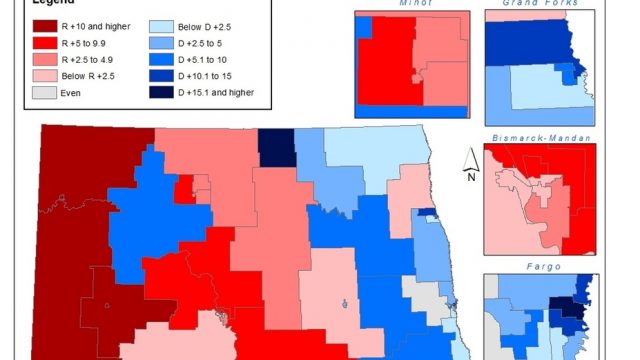North Dakota Goes From Top 10 Conservative To Top 10 Moderate In Poll

Is North Dakota moving to the left? I’m not sure you could say that based on recent election results. In 2014 all Democrats could do against a Republican supermajority which has lasted for more than a generation now is a net 1 seat pickup in the Legislature. Even the most resounding victory Democrats have enjoyed in years – Heidi Heitkamp’s 2012 Senate win – wasn’t really a pickup in that it was a seat Democrats had held since the 1960’s. Heitkamp barely held onto it, and that was perceived as a monumental victory only because she was perceived as such an underdog to Republican Rick Berg.
So, I don’t sense that North Dakota is moving left. But according to Gallup, the state’s citizens are perceiving themselves as being more moderate.
The percentage of North Dakota residents who described themselves as conservative ranged from 49 percent in 2010, when the state ranked sixth most-conservative by Gallup, to 48.6 percent in 2012, when it ranked second in a tie with Wyoming.
Then, in 2013, North Dakota respondents describing themselves as conservative dipped to 42.9 percent and the state fell out of the top 10, to 13th most-conservative in Gallup rankings.
The trend continued in 2014, when 41 percent called themselves conservative and 40.8 percent called themselves moderate.
There could be two things at play here.
 For one, the state has seen a pretty rapid shift in its demographics over those years mentioned. Not only as the state had one of the fastest growth rates in terms of population over the last several years, but the state is demographically getting younger. That’s undoubtedly going to move the needle on the ideology scale.
For one, the state has seen a pretty rapid shift in its demographics over those years mentioned. Not only as the state had one of the fastest growth rates in terms of population over the last several years, but the state is demographically getting younger. That’s undoubtedly going to move the needle on the ideology scale.
For another, the outcome of national elections may be shifting how North Dakotans perceive themselves politically. Again, North Dakota is a very Republican state. Back in 2010 when Democrats still held a supermajority in Washington DC I think North Dakotans probably perceived themselves as being more conservative relative to the national political mood. But as Republicans gained ground in Congress in 2010 (they took the House) and 2014 (they took the Senate), they probably began to perceive themselves as “moderate.”
Which is a political term I really dislike anyway. Because, really, what does it mean? To describe oneself as moderate is to imply that those who disagree with you politically are immoderate. Or, you know, extreme.
I think most people tend to see their own views as reasonable, and the views of those who disagree with them as unreasonable or extreme.
It’s a problematic term. And really, this sort of polling is just an exercise in self-perception. Interesting, but I’m not sure that it really indicates any sort of a meaningful shift in ideology. At least here in North Dakota anyway.
It does give me an excuse to reference some excellent work done by Minnesota State-Moorhead Political Science Professor Mark Johnson who has created what he calls a “partisan index” for North Dakota broken down by legislative district. Check out the map above.
There’s always a lot of talk about how “conservative” or “liberal” one part of the state is versus another. Well, Johnson has done the math and calculated how “Republican” versus “Democrat” each part of the state is based on election results.
It’s fascinating to look at. Obviously, tropes about the conservative west versus the liberal east generally hold up with some exceptions (mostly due to the Indian reservations).
Keep in mind, though, that these intensity measures are relative. They measure how much of an advantage Republicans or Democrats have relative to the statewide average. So, for instance, in District 1 (far west Williston area) Republicans have a more than +10 advantage over the average statewide advantage Republicans enjoyed which was 60 percent to 37 percent in the 2014 election.
So, basically, those deep red areas are really, really Republican. And even those white and light blue areas are still pretty Republican.
To the right is a breakdown of partisanship by lawmakers in each district, from most partisan Democrat to most partisan Republican.




